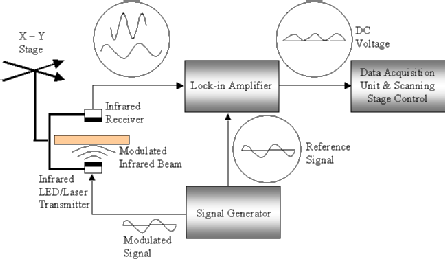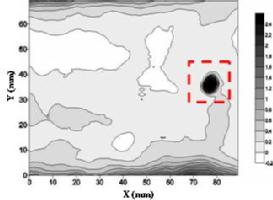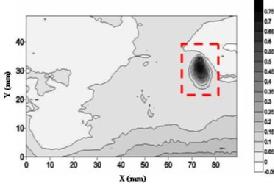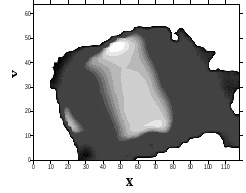Near Infrared (NIR) measurements in food
The DEFRA Foodlink Programme in NIR technology
This research, sponsored by DEFRA, UK, was performed as feasibility study into the use of Near Infrared (NIR) signals as a method to test food materials. The work used a modulated NIR source, with the received signal being detected and passed to a lock-in amplifier. This approach allowed the SNR to be enhanced substantially, allowing images and other measurements to be performed, as shown in Figure 1.

Figure 1:Experimental arrangement for NIR evaluation of food samples.
This approach has been used to look at a wide range of foodstuffs, in collaboration with Industrial Partners. These were in the general areas of baked goods and dough samples (BakeMark UK), cheese products (Kerrygold Ltd), meat (Westler Foods) and confectionary (Cadbury Ltd). Examples are given below.
Dough Samples
Dough is an example of a material that is very difficult to inspect using techniques such as ultrasound. However, it is possible to transmit NIR signals through such food materials to form an image. Examples are shown in Figure 2, where the technique has detected contaminants in the form of a 5 mm diameter glass sphere and a piece of copper wire. Whilst the metal wire could have been picked up by X-rays or metal detectors, the detection of glass would be more difficult.
 |
 |
| (a) | (b) |
Figure 2:NIR through-transmission image of a dough sample containing (a) a glass sphere and (b) a copper wire as a simulated contaminant.
Cheese
The detection of non-metallic contaminants has been one of the objectives of this Bridgelink study. A good example is shown in Figure 3, where the technique has been able to find a rubber inclusion within a cheddar cheese sample, whilst still in its wrapper.
 |
 |
| (a) | (b) |
Figure 3:(a) Photograph of a block of cheese, in its packaging, within which a 10 mm diameter piece of rubber has been inserted. (b) The resulting NIR scan, indicating clearly the presence of the rubber within the block of cheese.
Meat
It was found that NIR signals could be easily transmitted through lean meat samples, whereas it is more highly-absorbed in fat. This is shown in Figure 4, where the photograph on the left shows two pieces of pork, plus a strip of fat. The two halves were then put one on top of the other, with the fat hidden inside. The NIR image that resulted, shown on the right, illustrates that the attenuation in the fat (shown as the lighter shade) was much greater. This illustrates that NIR could perhaps be used to determine the fat concentration of certain meat products.
 |
 |
| (a) | (b) |
Figure 4:(a) Photograph of a strip of fat sandwiched between two layers of pork meat. (b) A NIR through-transmission image, in
Chocolate
Chocolate is also surprisingly transparent to NIR signals. However, nuts, raisins and contaminants are less so, and hence it is possible to provide contrast in imaging. As an example, Figure 5 shows a high-contrast NIR image of a chocolate sample containing nuts, which show up as the lighter shades in the image. From such measurements, it would be possible to estimate the nut distribution throughout the chocolate bar.

Figure 5: NIRimage following a scan of a chocolate sample containing nuts, which show up as the lighter regions.
